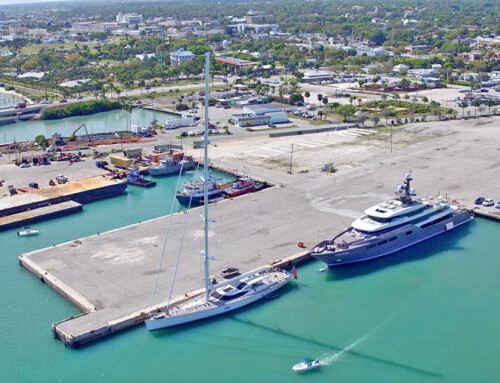The Fisherman’s Wharf project has received a grant to assist with technical planning. Photo of the Port of Fort Pierce courtesy the City of Fort Pierce.
FORT PIERCE – St. Lucie County’s Fisherman’s Wharf project was recently awarded a $35,000 community planning grant by Florida’s Department of Economic Opportunity (DEO). These grants are provided as technical planning assistance and were presented in varied amounts to 43 local governments and regional planning councils.
Fisherman’s Wharf is a joint city and county plan. St. Lucie County and the City of Fort Pierce have entered into an agreement to work collaboratively to develop the Port, as St. Lucie County is designated as the Port of Fort Pierce Port Authority, which lies within the jurisdictional authority of the City of Fort Pierce.
Fisherman’s Wharf is located at the southern end of the Port and acts as a buffer between the working port area and historic downtown Fort Pierce. It is currently underutilized and prime for redevelopment. The county and city are moving forward to develop a Fisherman’s Wharf Plan which will address connectivity and buffering, a market feasibility study, urban design, street design, massing and scale, and three conceptual site plans and elevation renderings integrating the findings from the plan.
The Fisherman’s Wharf Plan will utilize and incorporate findings from all previous plans addressing Fisherman’s Wharf, including Port of Fort Pierce Master Plan (as jointly adopted by St. Lucie County and the City of Fort Pierce, 2002) and Port of Fort Pierce Master Plan Update, 2013; Fisherman’s Wharf Development Study, 2015 (studied parcel purchase options for public use); Martin and St. Lucie Regional Waterways Plan, 2014; Downtown/Waterfront Charrette, 2008; and Taylor Creek Charrette, 2007.
The Port of Fort Pierce is one of 14 deep water seaports in the State of Florida, located within walking distance of historic downtown Fort Pierce. Downtown Fort Pierce was named by USA Today as one of the top 10 “idyllic and historic” downtowns in the United States in 2015, as well as the Great American Main Street Award from the National Trust for Historic Preservation in 2011. Planning for the redevelopment of a high quality “transition zone” between the working port and the historic downtown will serve to impact the region by clearly defining the active working port area while protecting and supporting a vibrant historic downtown.
The majority of the funding ($25,000) will be spend towards the creation of three alternate conceptual site plans illustrating street design and amenities, building massing and scale and location of parking, bus/trolley and storm-water infrastructure.

